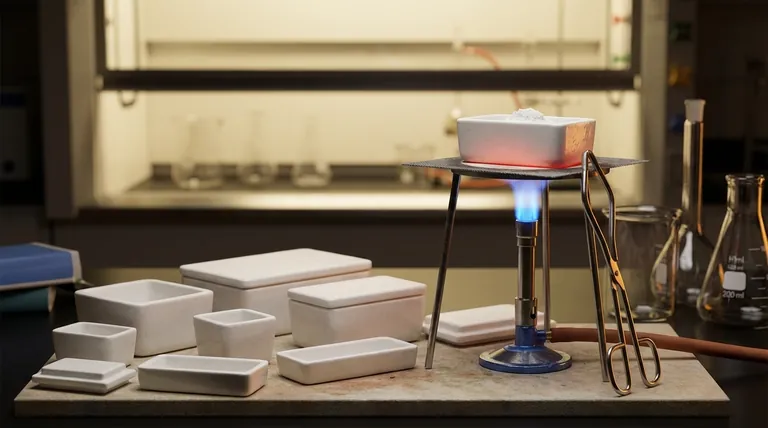Porcelain is the material of choice for general-purpose laboratory crucibles because of its unique and balanced combination of properties. It can withstand extremely high temperatures without melting or deforming, it is highly resistant to chemical attack from most acids, and it is exceptionally cost-effective for a wide range of applications.
The core reason for porcelain's widespread use is not that it excels at one single task, but that it provides the most reliable and affordable performance across the most common high-temperature laboratory procedures.

The Core Properties of a Porcelain Crucible
To understand why porcelain is so common, we need to look at the specific demands of laboratory heating processes. A crucible must contain a sample, endure intense heat, and not interfere with the chemical analysis.
Extreme Heat Resistance
Porcelain is a ceramic material, meaning it is formed and hardened by firing at very high temperatures. This process makes it inherently stable when reheated.
A typical glazed porcelain crucible can safely withstand temperatures up to 1150°C (2100°F), which is sufficient for most standard laboratory procedures like ashing organic matter or drying precipitates.
Superior Chemical Inertness
A crucial requirement is that the crucible itself does not react with the substance being heated.
The smooth, glass-like glaze on a porcelain crucible creates an impermeable and non-reactive barrier. This surface is highly resistant to almost all acids and corrosive reagents, ensuring the integrity and purity of the sample.
Stability Against Thermal Shock
Crucibles are often moved from a room-temperature benchtop directly into a hot furnace or flame. This rapid temperature change creates immense stress on the material.
Porcelain has a relatively low coefficient of thermal expansion, which allows it to tolerate these sudden temperature shifts without cracking.
Mechanical Durability
While brittle if dropped, porcelain is a hard, dense material with good compressive strength. It can be securely gripped with tongs and withstand the minor scrapes and handling typical of a laboratory environment.
Understanding the Trade-offs and Limitations
No material is perfect for every situation. Being a trusted advisor means knowing not only when to use a tool, but also when not to.
Not for Strong Alkalis
While exceptionally resistant to acids, porcelain can be attacked by hot, molten alkaline substances. Strong bases like sodium hydroxide (NaOH) or potassium hydroxide (KOH) will corrode the crucible at high temperatures, contaminating the sample and damaging the equipment.
Not for the Highest Temperatures
Porcelain has a clear upper temperature limit. For applications requiring temperatures above 1200°C, more specialized and expensive materials are necessary. Crucibles made from alumina, zirconia, or even platinum are used for these extreme conditions.
Inherent Brittleness
Like all ceramics, porcelain is brittle. It can easily shatter if dropped onto a hard surface or if subjected to a sharp mechanical impact. Careful handling is always required.
Making the Right Choice for Your Application
Selecting the correct crucible is fundamental to achieving accurate and safe results. Your choice depends entirely on the chemical nature of your sample and the temperature you need to achieve.
- If your primary focus is general chemistry, ashing, or drying samples: Porcelain is the ideal, cost-effective standard due to its excellent heat and acid resistance.
- If you are working with strong molten alkalis (bases): You should select a crucible made of a more resistant material like nickel or iron.
- If your procedure requires temperatures above 1200°C (2200°F): You must upgrade to a specialized high-temperature crucible made from alumina or platinum.
Choosing the right material ensures the accuracy of your results and the safety of your experiment.
Summary Table:
| Property | Benefit for Laboratory Use |
|---|---|
| Heat Resistance | Withstands temperatures up to 1150°C (2100°F), ideal for ashing and drying. |
| Chemical Inertness | Highly resistant to most acids, ensuring sample purity. |
| Thermal Shock Resistance | Tolerates rapid temperature changes without cracking. |
| Cost-Effectiveness | Provides reliable performance at an affordable price for general applications. |
Need the right crucible for your specific application? The experts at KINTEK can help you select the perfect lab equipment. Whether you require standard porcelain crucibles or specialized alternatives for high temperatures or alkaline substances, we provide the durable, high-performance solutions your laboratory needs. Contact our team today for personalized advice and ensure the accuracy and safety of your experiments.
Visual Guide

Related Products
- Engineering Advanced Fine Alumina Al2O3 Ceramic Crucible for Laboratory Muffle Furnace
- Alumina Al2O3 Ceramic Crucible Semicircle Boat with Lid for Engineering Advanced Fine Ceramics
- Engineering Advanced Fine Ceramics Alumina Al2O3 Crucible With Lid Cylindrical Laboratory Crucible
- Engineering Advanced Fine Ceramics Alumina Crucibles (Al2O3) for Thermal Analysis TGA DTA
- Arc-Shaped Alumina Ceramic Crucible High Temperature Resistant for Engineering Advanced Fine Ceramics
People Also Ask
- What is a crucible material for a furnace? A Guide to Choosing the Right High-Temperature Container
- What needs to be checked before using a crucible? A Guide to Safe and Effective High-Temperature Work
- What is a crucible porcelain? Choosing the Right High-Temperature Lab Vessel
- How much heat can a ceramic crucible withstand? A Guide to Material-Specific Temperature Limits
- How many times can you use a crucible? Maximize Lifespan and Ensure Safety



















